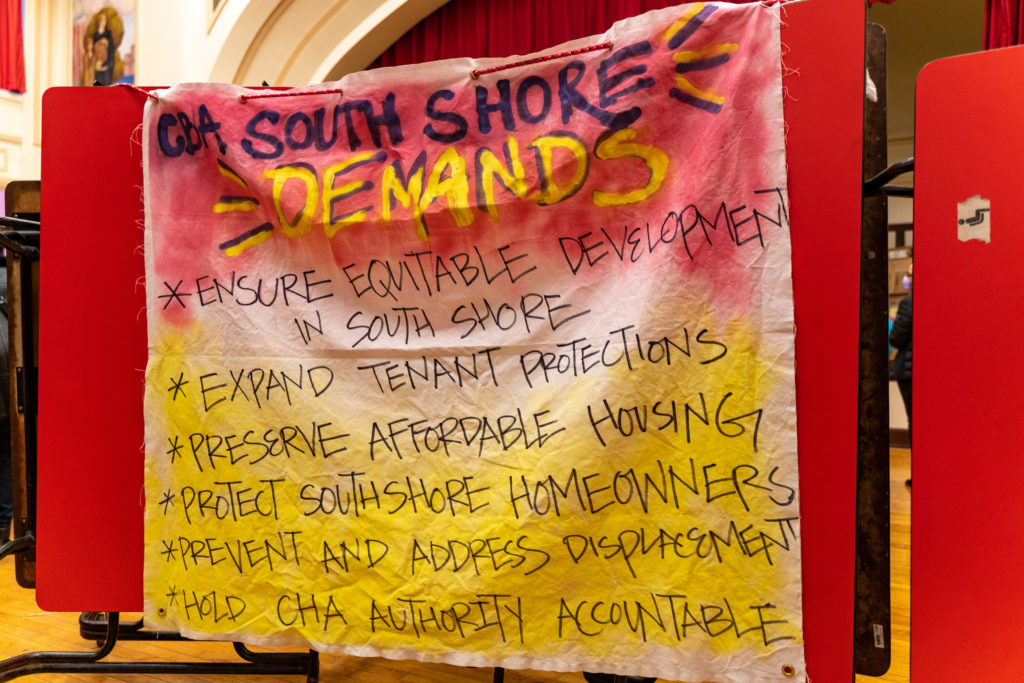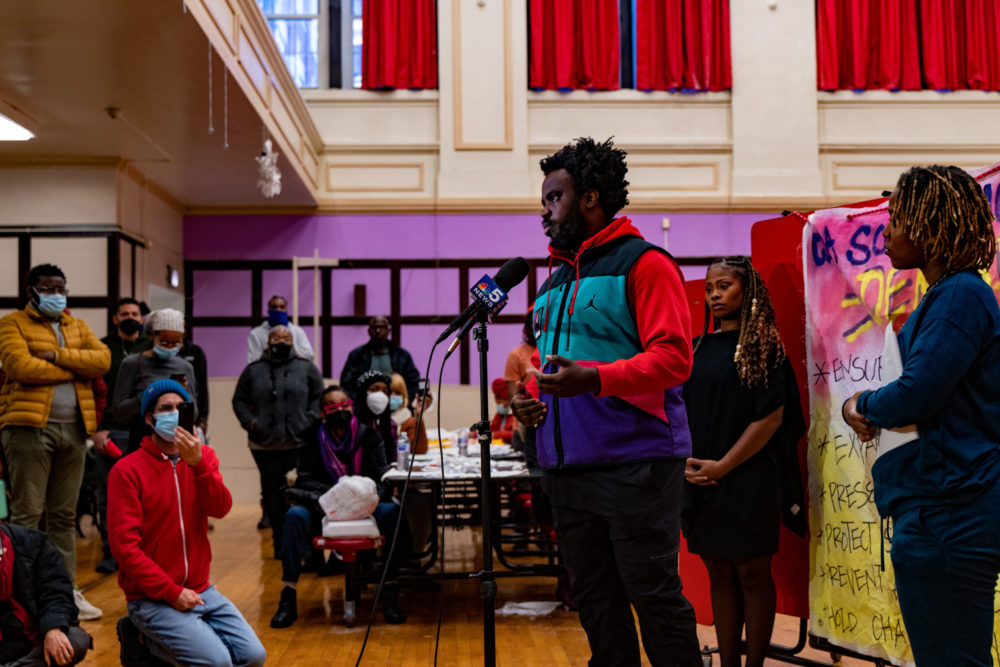Jacky Brooks has lived in Woodlawn for three years and recently has been looking to put down roots in South Shore by purchasing a home there. But they ran into repeated road blocks.
To start, every house that they looked at required a certain degree of rehabilitation, which was not in Brooks’ budget. When they went to look at condos, they found that in order to utilize their Federal Housing Association loan for first-time homebuyers when buying a condo, fifty percent of the condos in the respective building must be owner-occupied. If there are no buildings that meet this standard, then the buyer must pay for the condo outright, without the loan, and Brooks couldn’t afford that either.
“[For] folks that want to come back and live and be in the community, there are barriers now around it,” Brooks said. “I was privileged, I had enough space to be able to try to do that, but if that’s what I’m experiencing at this level, then I can already connect the dots of what it’s like for renters and other folks.”
Brooks, who is a member of the South Shore community organization NotMeWe, which has agitated for a community benefits agreement (CBA) that would protect residents from being forced out of the area by skyrocketing property values, said they saw this as another sign of the displacement to come as construction of the Obama Presidential Center (OPC) gets underway.
The OPC’s website talks of the many benefits the center will bring to the South Side communities surrounding it, including youth programming, workforce development and jobs and a space for community members to gather.
But one of the biggest questions that residents have spent years asking is, will they still be in the community to see it?
In September, as Barack and Michelle Obama—who have thus far declined to support any community benefits agreement—attended a groundbreaking ceremony for the OPC in Jackson Park, a coalition of community groups gathered a few blocks north to continue to demand guarantees for the surrounding communities.
The Coalition for a CBA, which includes community groups from Kenwood, Hyde Park, Woodlawn, and South Shore, has already secured a City ordinance that offers some protection to residents. The Woodlawn Preservation Ordinance, which the City Council passed last year, includes $4.5 million for affordable-housing programs in that neighborhood. But the Coalition says it doesn’t go far enough.
The coalition is focused on two issues: holding the City accountable to following through with the Woodlawn Ordinance and introducing a similar CBA for South Shore.
But one thing that South Shore doesn’t have is time. It took the coalition five hard-fought years to even get the CBA introduced to City Council. Now, as the OPC breaks ground, for residents in South Shore without any source of protection, the danger of displacement is imminent.
A few days after the Obamas broke ground in Jackson Park, NotMeWe hosted a series of in-person and virtual town halls for South Shore residents to voice their concerns and help devise the demands in the South Shore-specific CBA.
“I think the biggest takeaway from the town halls was that everyone acknowledges that there’s a serious housing issue in South Shore, whether it’s renters—which is the majority of the neighborhood—but also condo owners and homeowners,” said Dixon Romeo, an organizer with NotMeWe. “Overwhelmingly, the majority of folks understand that unless we have protections, we’re going to get priced out of the community or displaced. For those who may be able to stay, they won’t be able to really maximize the benefits of this center because they’ll be worrying about holding on to their property.”
Even without the looming threat of gentrification, housing troubles are not new to the South Shore community. In 2017, the Reader’s Maya Dukmasova reported that more evictions were happening in South Shore’s primary ZIP code, 60649, than any other ZIP code in the city.
In 2020, City Bureau highlighted this continued disparity in a series where South Shore renters voiced concern that any investment in South Shore would be accompanied by displacement.
Displacement in Chicago is not new. And when it comes to preventative action against gentrification, there is research that shows how governments can avoid displacement.
A study published in 2019 by the University of Illinois Chicago’s Nathalie P. Voorhees Center for Neighborhood and Community Improvement instructed the City on the best way to help residents in Woodlawn: create more affordable housing. The study even identified the correctly zoned, City-owned land in Woodlawn where the housing could be built.
But what about affordable housing for South Shore?
South Shore’s absence from the CBA that became the Woodlawn Ordinance has created friction between organizers and Alderperson Leslie Hairston (5th), with organizers claiming that South Shore has always been in need of the same guarantees as Woodlawn.
“If people are naming that they need this [affordable housing], people are literally naming their needs, coming to town halls, engaging in community conversation, about the things that they’re facing in their homes right now. If you are really having conversations with people, you will be so shocked to hear what people are experiencing in their homes on a regular basis,” said Trina Reynolds-Tyler, co-founder of NotMeWe and resident of South Shore.
Hairston told the Weekly that she believes South Shore and Woodlawn are different spaces with different demographics and therefore would require different CBAs. She also extended an invitation to South Shore residents to come to her to discuss their concerns.
Organizers say that increasing affordable housing and establishing housing protections in South Shore isn’t just a matter of housing, but also one of safety and care for community members.
Reynolds-Tyler’s family has a deep, long-term connection in South Shore. The home where she currently resides has been in her family for decades. She wants to continue building her family’s legacy there, but said she is concerned for the future of the community.
“The displacement of Black communities, displacement of communities, period, is ultimately violent and leads to more violence. This is where I want to raise my family. I’m engaging in community on a regular basis and I want to feel safe and I know that many people don’t feel safe,” Reynolds-Tyler said.
“Safety, public safety, would be doing these things and building protections for South Shore residents so that people can be able to not just survive here…so many people are just barely surviving, but not actually thriving. A community [should] foster stability.”
On November 14, following months of community engagement and consultations with researchers and attorneys, NotWeMe presented the organization’s full list of demands to the public. The list is split into six sections and eighteen specific demands, each including precise policies and practices that could be implemented by the City to not just ensure that residents can remain in South Shore, but also thrive there.

Here’s a look at some of the CBA demands:
Prevent and Address Displacement: The Right to Return
When a building is bought and tenants are asked to leave in order for the buyer to make their desired rehabilitations, a right to return policy gives those tenants preference if they want to return back to their units after those changes are made. The right to return, or sometimes known as resident preference, is already being implemented in cities such as Seattle where displacement threatens the Black, Brown, and working-class communities in the city.
“We know that because of our proximity to the center, because of our proximity to the lake, that between now and the center’s construction in the years following, there will be new construction, there will be developments in South Shore,” Romeo said. “And so for those affordable units, who should have the priority to get those?”
Expand Tenant Protections: Create and Fund an Office of the Tenant Advocate
An Office of the Tenant Advocate, which is already established in cities such as New York and Washington D.C., would provide information and services regarding tenants’ rights. Such services include but are not limited to providing legal aid for tenants, emergency housing, and rental assistance programs.
Ensure Equitable Development in South Shore: Set Aside 100% of the City-owned Vacant Lots in South Shore for Affordable Housing Development
Furthermore, seventy-five percent of units must be reserved for residents who make fifteen to thirty percent of the area median income (AMI) with the other twenty-five percent of units reserved for those who make sixty percent of the AMI. This practice ensures that residents who make a lower percentage of the AMI and are in need of housing the most are prioritized for affordable housing.
Preserve Affordable Housing: Establish and Allocate a South Shore Loan Fund
The $5 million loan fund would go towards the rehabilitation of vacant single-family homes and multi-unit buildings. Sixty percent of units must be at thirty percent AMI and forty percent at thirty percent AMI.
Protect South Shore Homeowners: Establish a Renew South Shore Program
Said program would allocate $12 million to provide grants and down-payment assistance for South Shore residents. Also on the docket, is the call to allocate $20 million to the Long Term Homeowner Improvement Grant Program for South Shore homeowners. Finally, forgive the $2.3 million in tax debt owed by primarily low-income residents in the 5th and 7th wards.
“People are always saying, come back and invest and support and where you came from,” Brooks said.
“My question has been, what I’ve been really grappling with is, I’m seeing my community get displaced, so when we come back, I think particularly for young Black Chicagoans, we’re coming back and trying to live where we come from, what does it mean when we’re not able to do that financially, but also when our community is being displaced?”
Grace Del Vecchio is a Philadelphia-born, Chicago-based freelance journalist primarily covering movements and policing. She last wrote about Hyde Park Academy’s vote to replace one of their school resource officers with a dean of climate and culture.



I appreciate there’s a CBA between the City and Woodlawn organizations. That is a step in the right direction.
I am disappointed that the Obama foundation has not agreed to any CBA with Any community organization.
South Shore should get the same protection.